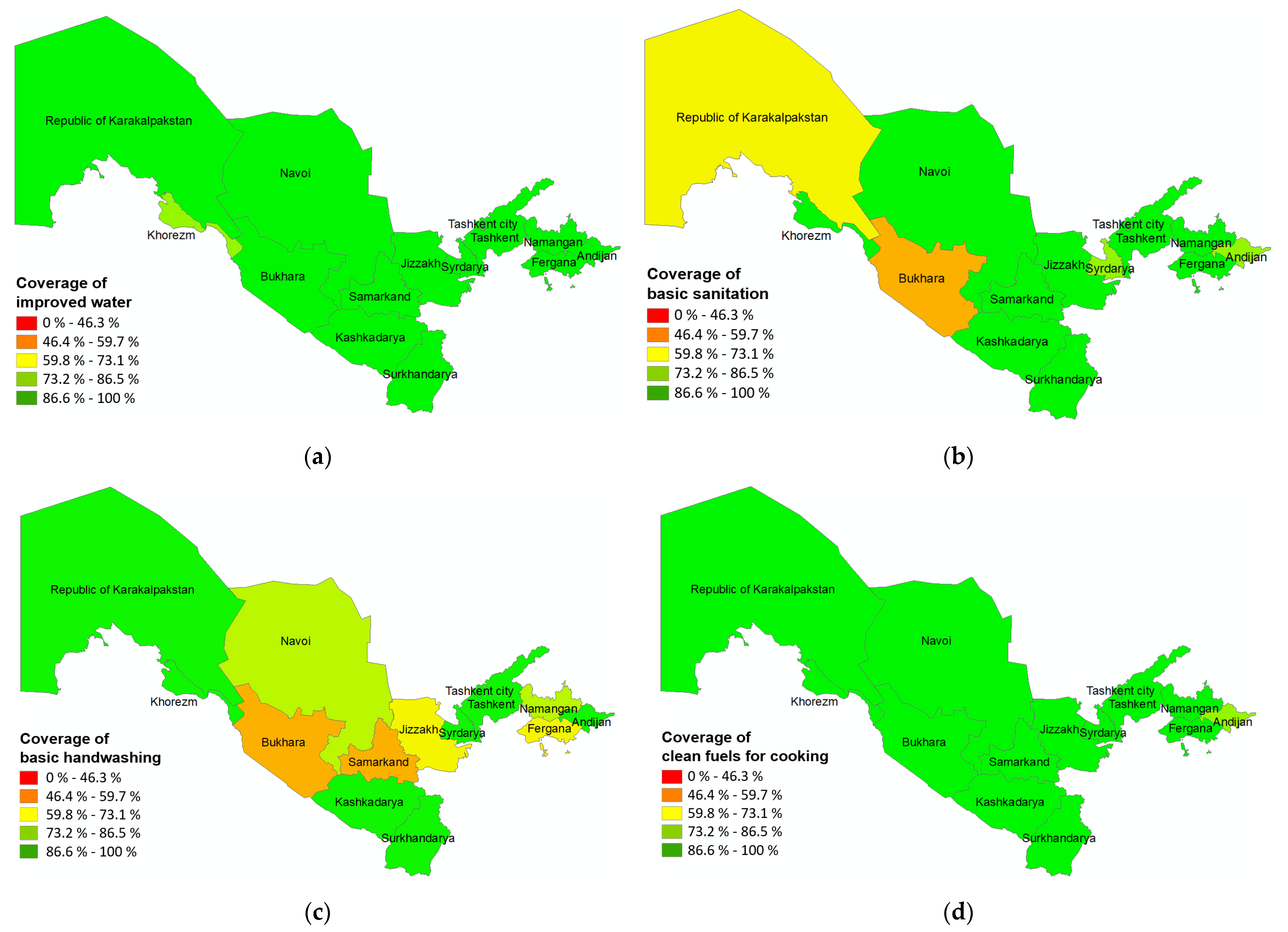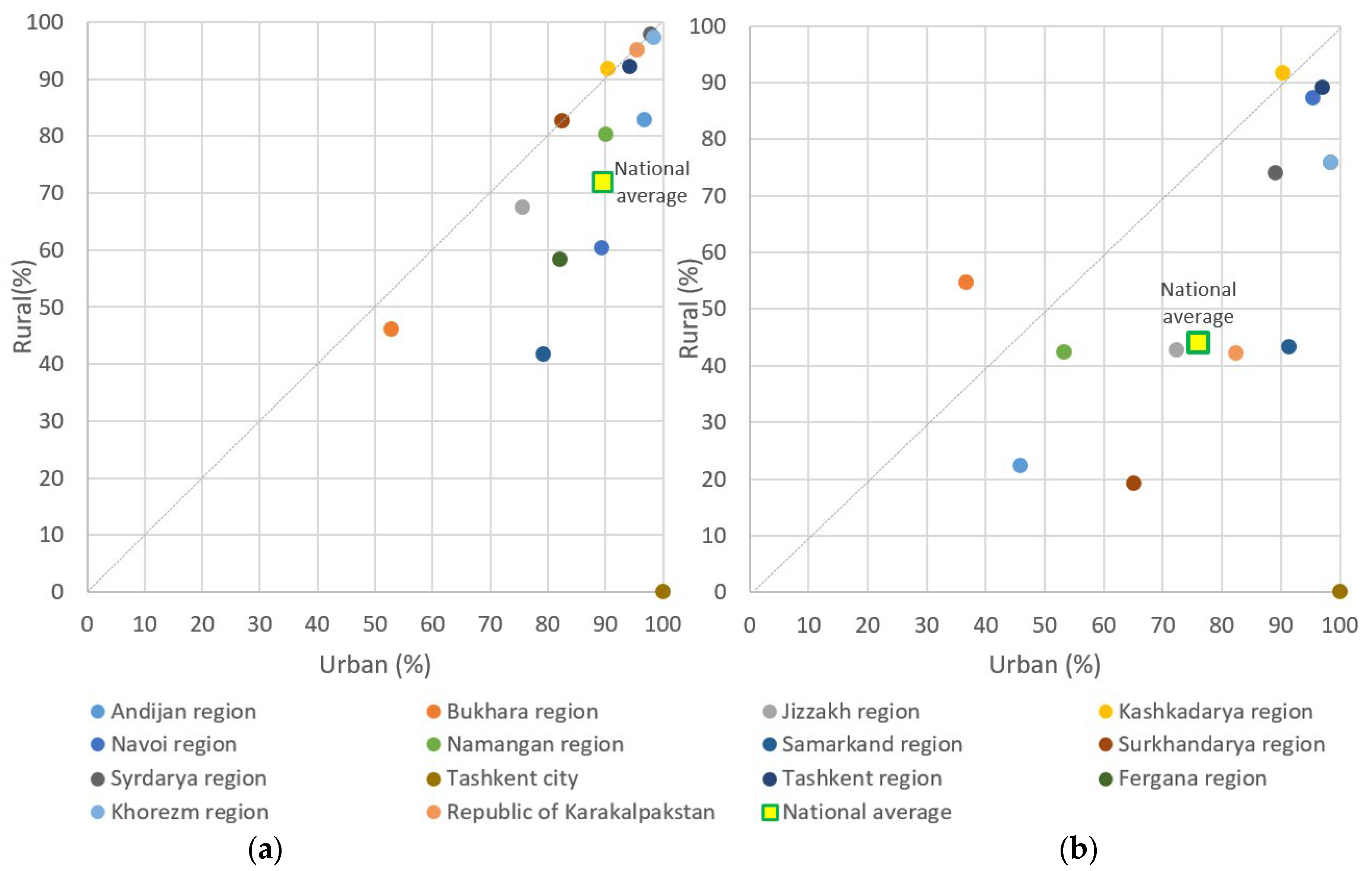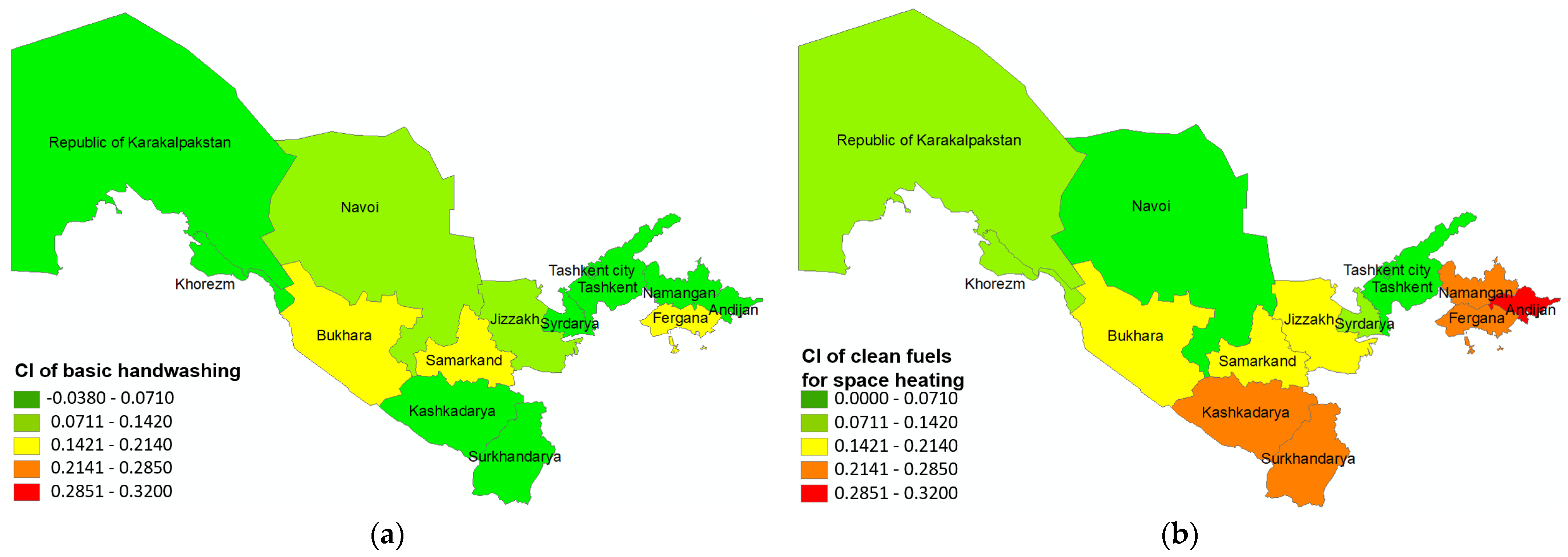Regional Disparities in Safe and Clean Environments in Uzbekistan: Analysis of 2021–2022 Uzbekistan Multiple Indicator Cluster Survey Data
Abstract
1. Introduction
2. Materials and Methods
2.1. Data Source and Sample Selection
2.2. Definition of Variables
2.3. Method of Inequality Analysis
3. Results
3.1. Regional Disparities in WASH and Clean Fuels Coverage
3.2. Measures of Inequality
4. Discussion
5. Conclusions
Author Contributions
Funding
Institutional Review Board Statement
Informed Consent Statement
Data Availability Statement
Conflicts of Interest
References
- United Nations Children’s Fund (UNICEF). UNICEF WASH Programme Contribution to COVID-19 Prevention and Response. 2020. Available online: https://www.unicef.org/documents/wash-programme-contribution-coronavirus-disease-covid-19-prevention-and-response (accessed on 26 August 2023).
- Brauer, M.; Zhao, J.T.; Bennitt, F.B.; Stanaway, J.D. Global access to handwashing: Implications for COVID-19 control in low-income countries. Environ. Health Perspect. 2020, 128, 57005. [Google Scholar] [CrossRef] [PubMed]
- Hillier, M.D. Using effective hand hygiene practice to prevent and control infection. Nurs. Stand. 2020, 35, 45–50. [Google Scholar] [CrossRef] [PubMed]
- World Health Organization. Environmental Health Uzbekistan 2022 Country Profile. 2022. Available online: https://www.who.int/publications/m/item/environmental-health-uzb-2022-country-profile (accessed on 26 August 2023).
- World Bank Group. Uzbekistan—District Heating Energy Efficiency Project. 2018. Available online: https://documents.worldbank.org/en/publication/documents-reports/documentdetail/591171517108418870/uzbekistan-district-heating-energy-efficiency-project (accessed on 25 August 2023).
- United Nations Economic Commission for Europe. 3rd Environmental Performance Review of Uzbekistan. 2020. Available online: https://unece.org/environment-policy/publications/3rd-environmental-performance-review-uzbekistan (accessed on 22 August 2023).
- Wolf, M.J.; Emerson, J.W.; Esty, D.C.; de Sherbinin, A.; Wendling, Z.A.; Mangalmurti, D.; Benedetti, C.; Keene, A.; Cong, R.; Lee, C.; et al. The 2022 Environmental Performance Index. 2022. Available online: https://epi.yale.edu/downloads (accessed on 22 August 2023).
- World Bank Group. People Using Safely Managed Drinking Water Services (% of Population)—Uzbekistan, Sub-Saharan Africa, Europe & Central Asia (Excluding High Income). 2020. Available online: https://data.worldbank.org/indicator/SH.H2O.SMDW.ZS?locations=UZ-ZG-7E (accessed on 12 September 2023).
- European Observatory on Health Systems and Policies; World Health Organization. Health Systems in Action: Uzbekistan: 2022 edition. 2022. Available online: https://apps.who.int/iris/handle/10665/362328 (accessed on 10 September 2023).
- World Bank. World Bank Supports Water Supply and Sanitation Sector Reforms and Infrastructure Development in Three Regions of Uzbekistan. 2020. Available online: https://www.worldbank.org/en/news/press-release/2020/03/12/uzbekistan-water-services-and-institutional-support-project (accessed on 7 July 2023).
- IQAir. Air Quality in Uzbekistan. 2023. Available online: https://www.iqair.com/uzbekistan (accessed on 13 August 2023).
- United Nations Development Programme. Energy Efficiency in Buildings: Untapped Reserves for Uzbekistan Sustainable Development. 2013. Available online: https://www.undp.org/uzbekistan/publications/energy-efficiency-buildings-untapped-reserves-uzbekistan-sustainable-development (accessed on 29 August 2023).
- Crighton, E.J.; Elliott, S.J.; Meer, J.; Small, I.; Upshur, R. Impacts of an environmental disaster on psychosocial health and well-being in Karakalpakstan. Soc. Sci. Med. 2003, 56, 551–567. [Google Scholar] [CrossRef] [PubMed]
- Veluswami Subramanian, S.; Cho, M.J.; Mukhitdinova, F. Health Risk in Urbanizing Regions: Examining the Nexus of Infrastructure, Hygiene and Health in Tashkent Province, Uzbekistan. Int. J. Environ. Res. Public Health 2018, 15, 2578. [Google Scholar] [CrossRef] [PubMed]
- Aripov, T.; Blettner, M.; Gorbunova, I. The impact of neighborhood to industrial areas on health in Uzbekistan: An ecological analysis of congenital diseases, infant mortality, and lung cancer. Environ. Sci. Pollut. Res. Int. 2020, 27, 17243–17249. [Google Scholar] [CrossRef] [PubMed]
- O’Donnell, O.; van Doorslaer, E.; Wagstaff, A.; Lindelow, M. Analyzing Health Equity Using Household Survey Data: A Guide to Techniques and Their Implementation. 2008. Available online: https://openknowledge.worldbank.org/entities/publication/8c581d2b-ea86-56f4-8e9d-fbde5419bc2a (accessed on 27 July 2023).
- World Inequality Database. Wealth Inequality, Uzbekistan, 1995–2021. 2021. Available online: https://wid.world/country/uzbekistan/ (accessed on 25 August 2023).
- Hohmann, S.; Garenne, M. Health and wealth in Uzbekistan and sub-Saharan Africa in comparative perspective. Econ. Hum. Biol. 2010, 8, 346–360. [Google Scholar] [CrossRef] [PubMed]
- Bomela, N.J. Social, economic, health and environmental determinants of child nutritional status in three Central Asian Republics. Public Health Nutr. 2009, 12, 1871–1877. [Google Scholar] [CrossRef] [PubMed]
- State Committee of the Republic of Uzbekistan on Statistics UNCsFU. 2021–2022 Uzbekistan Multiple Indicator Cluster Survey, Survey Findings Report. 2022. Available online: https://mics.unicef.org/surveys (accessed on 5 September 2023).
- United Nations Children’s Fund (UNICEF); World Health Organization. Core Questions on Drinking Water, Sanitation and Hygiene for Household Surveys: 2018 Update. 2018. Available online: https://washdata.org/reports/jmp-2018-core-questions-household-surveys (accessed on 13 July 2023).
- World Health Organization. Handbook on Health Inequality Monitoring with a Special Focus on Low- and Middle-Income Countries. 2013. Available online: https://apps.who.int/iris/handle/10665/85345 (accessed on 27 July 2023).
- Phillips, A.E.; Ower, A.K.; Mekete, K.; Liyew, E.F.; Maddren, R.; Belay, H.; Chernet, M.; Anjulo, U.; Mengistu, B.; Salasibew, M.; et al. Association between water, sanitation, and hygiene access and the prevalence of soil-transmitted helminth and schistosome infections in Wolayita, Ethiopia. Parasit Vectors 2022, 15, 410. [Google Scholar] [CrossRef] [PubMed]
- Sesay, B.P.; Hakizimana, J.L.; Elduma, A.H.; Gebru, G.N. Assessment of water, sanitation and hygiene practices among households, 2019—Sierra Leone: A community-based cluster survey. Environ. Health Insights 2022, 16, 11786302221125042. [Google Scholar] [CrossRef] [PubMed]
- World Bank Group. Uzbekistan—Water Supply, Sanitation and Health Project; and Bukhara and Samarkand Water Supply Project. 2015. Available online: https://documents.worldbank.org/en/publication/documents-reports/documentdetail/222081468189534492/uzbekistan-water-supply-sanitation-and-health-project-and-bukhara-and-samarkand-water-supply-project (accessed on 6 September 2023).
- United Nations Economic Commission for Europe. Uzbekistan’s Accession to the Protocol on Water and Health Opens New Opportunities for Stronger Action on Water, Sanitation, Hygiene and Health. 2024. Available online: https://unece.org/climate-change/press/uzbekistans-accession-protocol-water-and-health-opens-new-opportunities (accessed on 20 December 2023).
- Iraqi Civil Society Solidarity Initiative. World Heritage Watch Resolution on Water Infrastructure Threatening World Heritage. 2018. Available online: https://www.iraqicivilsociety.org/archives/8827 (accessed on 6 September 2023).
- Asian Infrastructure Investment Bank. Environmental and Social Management Planning Framework (ESMPF) for Bukhara Region Water Supply and Sewerage Project (BRWWSP). 2021. Available online: https://www.aiib.org/en/projects/details/2020/approved/Uzbekistan-Bukhara-Region-Water-Supply-and-Sewerage-Project.html (accessed on 11 September 2023).
- Independent Evaluation Group. Uzbekistan—Bukhara & Samarkand Water Supply Project. 2012. Available online: https://ieg.worldbankgroup.org/ieg-search-icrr?search_api_fulltext=P049621 (accessed on 6 September 2023).
- Sitorus, R.J.; Wathan, I.; Ridwan, H.; Wibisono, H.; Nuraini, L.; Yusri; Kosim, G.; Nurdin, N.; Mamat, H.; Andrayani, I.; et al. Transmission dynamics of novel Coronavirus-SARS-CoV-2 in south Sumatera, Indonesia. Clin. Epidemiol.Glob. Health 2021, 11, 100777. [Google Scholar] [CrossRef] [PubMed]
- Baker, R.E.; Mahmud, A.S.; Miller, I.F.; Rajeev, M.; Rasambainarivo, F.; Rice, B.L.; Takahashi, S.; Tatem, A.J.; Wagner, C.E.; Wang, L.F.; et al. Infectious disease in an era of global change. Nat. Rev. Microbiol. 2022, 20, 193–205. [Google Scholar] [CrossRef] [PubMed]
- World Bank. Uzbekistan to Invest in Improving Energy Efficiency of Public Buildings, with World Bank Support. 2022. Available online: https://www.worldbank.org/en/news/press-release/2022/06/24/uzbekistan-to-invest-in-improving-energy-efficiency-of-public-buildings-with-world-bank-support (accessed on 20 December 2023).
- UZ DAILY. Uzbekistan Is Moving towards the Introduction of Best Practices in the Construction of Energy Efficient and Low-Carbon Buildings. 2022. Available online: https://uzdaily.com/en/post/73966 (accessed on 20 December 2023).
- Law of the Republic of Uzbekistan. On Introducing Amendments and Additions to the Law of the Republic of Uzbekistan “on the Protection of Atmospheric Air”. 2019. Available online: https://lex.uz/uz/docs/4238834#4239926 (accessed on 21 December 2023).
- Roche, R.; Bain, R.; Cumming, O. A long way to go—Estimates of combined water, sanitation and hygiene coverage for 25 sub-Saharan African countries. PLoS ONE 2017, 12, e0171783. [Google Scholar] [CrossRef]
- McKee, M.; Balabanova, D.; Akingbade, K.; Pomerleau, J.; Stickley, A.; Rose, R.; Haerpfer, C. Access to water in the countries of the former Soviet Union. Public Health 2006, 120, 364–372. [Google Scholar] [CrossRef] [PubMed]
- Tussupova, K.; Hjorth, P.; Berndtsson, R. Access to drinking water and sanitation in rural Kazakhstan. Int. J. Environ. Res. Public Health 2016, 13, 1115. [Google Scholar] [CrossRef] [PubMed]
- Statistics Agency under the President of the Republic of Uzbekistan. Which Region has the Highest Gross Domestic (Regional) Product per Capita? 2022. Available online: https://stat.uz/en/30879-qaysi-hududda-aholi-jon-boshiga-hisoblangan-yalpi-ichki-hududiy-mahsulot-eng-yuqori-4 (accessed on 5 September 2023).
- European Bank for Reconstruction and Development. Tashkent Water and Wastewater Modernization Project Feasibility Study. 2018. Available online: https://www.ebrd.com/documents/comms-and-bis/psd-49277-sep.pdf (accessed on 30 August 2023).
- Asian Development Bank. Uzbekistan: Second Tashkent Province Water Supply Development Project. 2023. Available online: https://www.adb.org/projects/51240-001/main (accessed on 30 August 2023).
- Veolia Group. Veolia Entrusted with the Operation, Maintenance and Management of the District Heating System of the City of Tashkent for a Duration of 30 Years. 2021. Available online: https://www.veolia.com/en/our-media/newsroom/press-releases/veolia-entrusted-management-district-heating-system-city-Tashkent (accessed on 12 September 2023).
- World Bank Group. Uzbekistan to Invest in Modernizing Its Energy Sector to Meet Growing Demand with Private Sector Participation and World Bank Support. 2023. Available online: https://www.worldbank.org/en/news/press-release/2023/05/09/uzbekistan-to-invest-in-modernizing-its-energy-sector-to-meet-growing-demand-with-private-sector-participation-and-world (accessed on 29 August 2023).
- World Bank Group. New Solar Power Plants to Be Launched in Uzbekistan with World Bank Support, Helping Expand Access to Clean Energy. 2023. Available online: https://www.worldbank.org/en/news/press-release/2023/03/07/new-solar-power-plants-to-be-launched-in-uzbekistan-with-world-bank-support-helping-expand-access-to-clean-energy (accessed on 29 August 2023).
- Tabiri, K.G.; Adusah-Poku, F.; Novignon, J. Economic inequalities and rural-urban disparities in clean cooking fuel use in Ghana. Energy Sustain. Dev. 2022, 68, 480–489. [Google Scholar] [CrossRef]
- Mensah, J.T.; Adu, G. An empirical analysis of household energy choice in Ghana. Renew. Sustain. Energy Rev. 2015, 51, 1402–1411. [Google Scholar] [CrossRef]




| Region | Basic Handwashing | Clean Fuels for Space Heating | ||||||||
|---|---|---|---|---|---|---|---|---|---|---|
| Average | Lowest | Highest | Ratio (Highest/Lowest) | CI ** | Average | Lowest | Highest | Ratio (Highest/ Lowest) | CI | |
| National | 82.0% | 67.4% | 99.4% | 1.5 | 0.0804 | 59.9% | 12.7% | 99.4% | 7.8 | 0.1697 |
| Andijan | 89.2% | 79.8% | 100% | 1.3 | 0.0465 | 33.1% | 12.5% | 100% | 8.0 | 0.3180 |
| Bukhara | 48.7% | 35.0% | 100% | 2.9 | 0.2061 | 47.8% | 18.0% | 100% | 5.5 | 0.1945 |
| Jizzakh | 71.5% | 37.8% | 100% | 2.6 | 0.1304 | 57.6% | 13.0% | 100% | 7.7 | 0.1624 |
| Kashkadarya | 91.0% | 87.1% | 100% | 1.1 | 0.0308 | 37.6% | 7.8% | 100% | 12.8 | 0.2197 |
| Navoi | 75.2% | 37.5% | 100% | 2.7 | 0.1303 | 92.2% | 50.0% | 100% | 2.0 | 0.0424 |
| Namangan | 86.5% | 85.7% | 93.9% | 1.1 | 0.0070 | 48.9% | 11.1% | 100% | 9.0 | 0.2179 |
| Samarkand | 54.6% | 5.2% | 100% | 19.2 | 0.1644 | 59.9% | 19.1% | 98.9% | 5.2 | 0.1802 |
| Surkhandarya | 92.3% | 98.3% | 92.9% | 0.9 | −0.0380 | 35.9% | 8.4% | 100% | 11.9 | 0.2542 |
| Syrdarya | 99.0% | 100% | 100% | 1.0 | 0.0009 | 81.3% | 40.0% | 100% | 2.5 | 0.0955 |
| Tashkent city * | 100.0% | 100% | 100% | 1.0 | 0.0010 | 100.0% | 100% | 100% | 1.0 | 0.0000 |
| Tashkent | 93.1% | 93.8% | 98.7% | 1.1 | 0.0294 | 92.8% | 31.3% | 98.7% | 3.2 | 0.0319 |
| Fergana | 68.7% | 42.2% | 100% | 2.4 | 0.1444 | 47.0% | 6.7% | 97.8% | 14.7 | 0.2433 |
| Khorezm | 97.6% | 100% | 100% | 1.0 | 0.0084 | 82.7% | 20.0% | 100% | 5.0 | 0.0735 |
| Republic of Karakalpakstan | 95.8% | 92.6% | 100% | 1.1 | 0.0141 | 63.4% | 3.7% | 100% | 27.0 | 0.1376 |
Disclaimer/Publisher’s Note: The statements, opinions and data contained in all publications are solely those of the individual author(s) and contributor(s) and not of MDPI and/or the editor(s). MDPI and/or the editor(s) disclaim responsibility for any injury to people or property resulting from any ideas, methods, instructions or products referred to in the content. |
© 2024 by the authors. Licensee MDPI, Basel, Switzerland. This article is an open access article distributed under the terms and conditions of the Creative Commons Attribution (CC BY) license (https://creativecommons.org/licenses/by/4.0/).
Share and Cite
Moon, J.; Choi, J.W.; Kim, K.H. Regional Disparities in Safe and Clean Environments in Uzbekistan: Analysis of 2021–2022 Uzbekistan Multiple Indicator Cluster Survey Data. Sustainability 2024, 16, 1580. https://doi.org/10.3390/su16041580
Moon J, Choi JW, Kim KH. Regional Disparities in Safe and Clean Environments in Uzbekistan: Analysis of 2021–2022 Uzbekistan Multiple Indicator Cluster Survey Data. Sustainability. 2024; 16(4):1580. https://doi.org/10.3390/su16041580
Chicago/Turabian StyleMoon, Juyoung, Jae Wook Choi, and Kyung Hee Kim. 2024. "Regional Disparities in Safe and Clean Environments in Uzbekistan: Analysis of 2021–2022 Uzbekistan Multiple Indicator Cluster Survey Data" Sustainability 16, no. 4: 1580. https://doi.org/10.3390/su16041580
APA StyleMoon, J., Choi, J. W., & Kim, K. H. (2024). Regional Disparities in Safe and Clean Environments in Uzbekistan: Analysis of 2021–2022 Uzbekistan Multiple Indicator Cluster Survey Data. Sustainability, 16(4), 1580. https://doi.org/10.3390/su16041580





